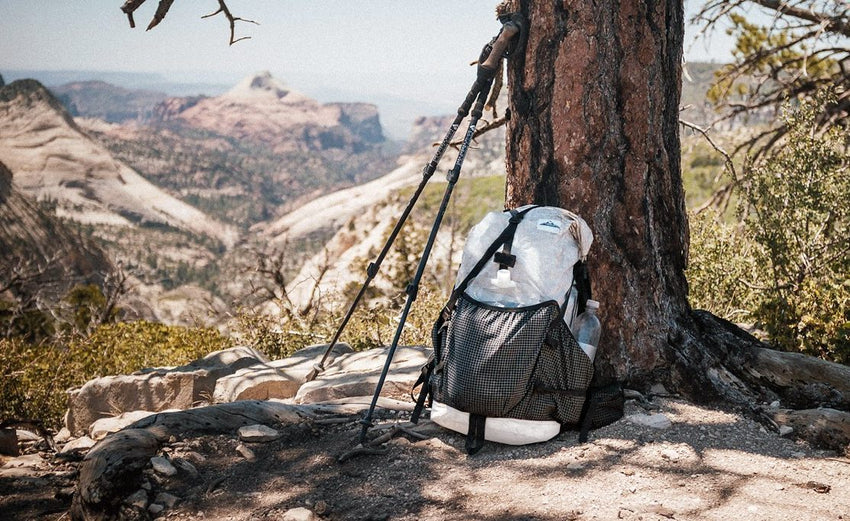How to Use Trekking Poles to Increase Speed and Decrease Fatigue

Text by Mike St. Pierre // Photo by Cody Cobb.
Why, Where & How to Use Trekking Poles
Trekking poles prevent muscle damage and soreness. The UK’s Northumbria University conducted a study in 2010 that found that the test groups that used poles, “demonstrated a reduced loss of strength and a faster recovery immediately after the trek compared to the control group.” They drilled it down even more, finding the levels of the enzyme creatine kinase (indicating muscle damage) were significantly higher in the non-pole group, while “the trekking-pole group’s levels were close to the pre-trekking levels.” That means muscle damage was negligible when people used poles. Various studies have shown that using poles can reduce the impact on your knees from 25-40%. The catch is, you have to know how to use trekking poles to get those benefits.
Choosing and Sizing Your Trekking Poles
In my opinion, poles are a necessity–not an option. I started out using twist lock poles, and they can be an excellent option. However, I found I constantly had to take them apart to clean them and finagle the locking mechanism to get them to work again. As a result, I now use flip lock carbon fiber poles because I’ve found them to be more stable over time. Flip locks are slightly heavier, but considering I break a couple of poles every year from hitting the trails hard, I try to find a balance of durability and weight.
The materials your poles are made out of is the next major consideration. Recent advancements have made carbon fiber trekking poles the obvious choice for adventures funds to spare. They’re ultralight and will dampen vibration while you’re on the trail, which translates to less fatigue over the course of thousands of pole strikes throughout the course of the day. The next lightest option will be aluminum. It’s a great option, but actually enhances vibration, which can lead to buzzing “power tool” hands.
When sizing your poles, you want to keep your arm parallel to the ground as a general goal. But also consider that if there are lots of roots and rocks, you’ll be picking your pole way up over and over again to clear those items. So in that terrain I keep my pole slightly shorter so I don’t have to lift the pole up so much and tire my arm out.
Bring Two, Carry One
Even though I bring two poles on almost every backpacking trip I embark on, though I only actually use one while hiking (more on that later). I typically use just one pole because I find it’s easier to switch hands when terrain is technical, and I noticed over the years that I (and others) tended to rely too much on two poles when tired or descending steeper terrain. I found I was tensing my body and trying to hold back from the gravity carrying me downhill. In turn, this stressed out my back, neck and shoulders. I felt I was contracting my muscles and tiring myself out faster. I solved this problem by switching to one pole.
In keeping with Hyperlite Mountain Gear’s philosophy that less gear equals more adventure, I always consider the possible duel purposes of every item I bring. Trekking poles are one of the most versatile tools we can use in the outdoors. You can use them as splints and to set up your shelter.
Setting up an ultralight tarp or pyramid tent without two poles takes significantly longer without them. You’ll spend time finding a big stick to use as a center pole or just the right tree to suspend it from. But save yourself the labor and time it takes to look for rocks and sticks by using poles. Bind them together with lash straps, shoelaces or a bandana to set up your mid, or use single poles for the various ways you set up your tarp.
“Trekking poles are the difference between two-wheel drive and four-wheel drive when you’re on the trail.” -Max Neale, writer & adventurer
The best thing about poles is that they don’t just save your knees. In fact, they can save your life. They make passage over treacherous, rocky, root-covered or unstable terrain easier. They also allow you to balance better when fording a river or walking across wet logs. I shorten them significantly when I climb steep terrain, using them much like a mountaineer might use an ice axe. I’ll stab it into scree or even snow above me to keep from slipping downslope.
Not Just For Thru Hikers Anymore
Finally, poles aren’t just for thru-hikers and backpackers. Anyone adventuring into the backcountry could benefit from them. We know a climber who doesn’t leave the trailhead for her rock climbing excursions without them, though, she says, she doesn’t see climbers regularly using them on the trail.
“I’ve always just used them because my ankles are so bad,” she explained to me. “But I really learn how to use trekking poles from thru hikers, who taught me that they’re just so versatile.”
I agree. Long-distance hikers and ultralight backpackers have really dialed in the best ways to cover the most amount of terrain in the most efficient manner. There’s a lot to be learned from people who are walking every day for four to six months, traversing huge swaths of terrain. Get into four-wheel drive mode, and buy yourself a couple poles. It’s well worth it.
The post How to Use Trekking Poles to Increase Speed and Decrease Fatigue appeared first on Hyperlite Mountain Gear Blog.